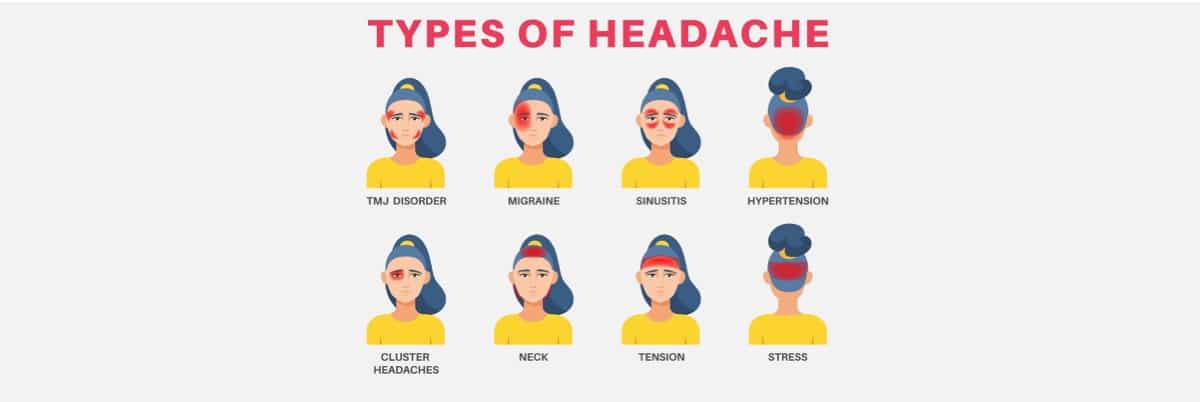
Not all headaches are created equal, from eye strain all the way up to migraines. Learn how to tell the difference and what you can do about it.
“I have a headache.” If you had a dollar for every time you or someone you know said that, you’d probably have enough money to fund a cure for headaches. Though headaches are common, they’re not an easy-to-fix issue. Paying attention to the clues and the location of the symptoms can ultimately help determine the cause.
Not all headaches are created equal, from eye strain all the way up to migraines. Let’s review the different types of headaches:
These headaches are caused by stress, which causes muscles to tighten. There is often a band-like headache that wraps around the skull. Picture, for a moment, an 80s sweatband — that’s where the pain is. The hunching of shoulders puts pressure on the neck, which puts pressure on the head.
The neck can cause this headache. It wraps around from the base of the skull, up and over to the eye area, specifically on one side, and pain can occur when you move your head or neck. Patients may try to find relief through pushing on the upper part of the neck at the base of the skull, or trying to stretch the neck when it’s stiff.
Has your face ever felt like it was going to explode behind your eyes, on the middle of your forehead, or have you had referred pain reaching down to your gum area? You’ve probably been the victim of the sinus headache–a nasty combination of facial pain plus a headache. Seasonal allergy sufferers are likely the most familiar with the pressure and pain of this condition.
Similar to Cervicogenic headaches, pain of the TMJ (temporomandibular joint), or TMD (temporomandibular disorder), typically affects only one side (of the jaw). This popping, aching and pain in the jaw area can be caused by teeth clenching or trauma to the head, neck, or jaw, forcing the area out of alignment. Read more in our blog post about TMD and the TMJ and the role of chiropractic.
If you’ve had one, you know what we’re talking about. If you haven’t had one, just hope that you never will. This typically one-sided, debilitating headache affects vision, hearing, and balance through special symptoms like aura (visual disturbances, or described as the ability to see sound), nausea, or vertigo. While some patients have 1-2 in their lifetime, other patients with severe cases may have up to 3-4 migraines per week. There are many possible causes or triggers for migraines, ranging from hormones and stress to food sensitivities.
Thirsty? Dizzy? Confused? Have you had any water to drink today? You might be dehydrated. This type of headache varies by person. It can include pulsing or throbbing on both sides of the head, and is typically worse with movement–even walking. During an episode of dehydration, brain tissue can shrink, and your brain may have to work harder to make up for it.
Yes, digestion headache. Sounds unrelated. However, this headache is linked to and is typically accompanied by stomach upset and/or diarrhea. This headache pain can occur in a band around the head, or around the eye area. It’s typically seen in patients with chronic GI conditions, such as IBS or Crohn’s disease during a flare-up/episode.
After everyone began working (and schooling) from home, an entire sector of the world began suffering from eye strain. The pain associated with eye strain is similar to tension headache or migraine pain. It can be triggered by prolonged reading or hours of computer work. It almost goes without saying, but we’ll say it anyway: this affects students and anyone who works long hours at a computer.
When the headache hits, you don’t want to (or can’t even) think too hard about what to do next. There are two methods to the madness here: fix it now or fix it later–”both” is also a choice, and honestly, it’s the best idea. Please note: Any age group can get headaches, but kids rarely get headaches. If your child complains of a headache, get them checked out immediately. Trauma from a football tackle or a car accident can have big consequences.
1) Take over-the-counter pain relief you need–whether it’s Advil, Tylenol or Aleve.
2) Apply ice and heat. Yes, both. Place the ice pack at the back of your head, and place the heating pad at your shoulders or between your shoulder blades. After 10 minutes, remove them.
3) Lay down. Go back to the 19th century and put away the phone, the tablet, and the TV remote. Rest your eyes and your head the old-fashioned way.
Some of these efforts aren’t a “fix it later” but are more of a “fix it with some time and patience, for lasting effect.”
Tension Headache solutions: Chiropractic will be a fantastic asset for aiding tension in your body, including an evaluation of your posture. Poor posture puts pressure on parts of your body, precipitating pain. (Say that five times fast!) When chiropractic is used in tandem with massage and stress relief/management, your body will start feeling looser and better.
At Element Chiropractic, we value getting to the root of the problem. We want to help determine the cause of the headache, whether it’s seasonal allergies or poor posture. If needed, we can take x-rays to investigate any underlying neck problems that may be contributing to your headaches.
In addition to working with you, we’re also dedicated to working towards the best solution for you, and are happy to co-manage with other providers, including medical doctors, naturopaths, acupuncturists, and licensed massage therapists. Teamwork makes the dream work. (The dream is you, living your life without headaches.)
Schedule an appointment to see how we can help with your headache!